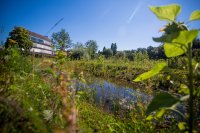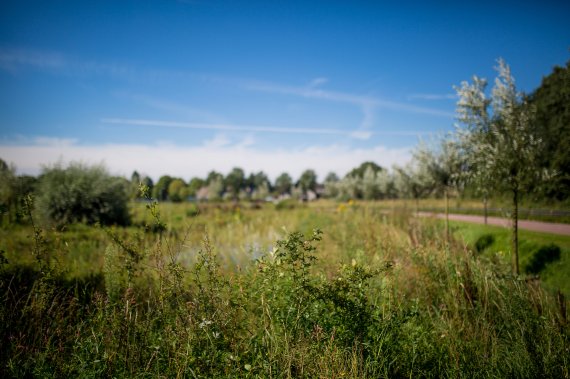Photo’s: Sven Menschel
From the bus lane, the field next to research institute Rikilt on the Wageningen campus looks like an overgrown jungle. Weeds stand shoulder-high and not much system is detectable. Last January this patch of ground was designated The Field: a place where all staff and students can experiment to their hearts’ content. The idea is to create a research garden where everyone is welcome with green plans that don’t fit in at a chair group or research group. And that makes The Field unique in Wageningen.
Experimental
When you actually walk into the field you can see some structure and order. To the right lies a vegetable garden, to the left a flower garden. Paths cut through the tall weeds and there are banks separating the Field into sections. Each section will house several projects. The organizers only accept a new plan if it won’t interfere with other projects, and preferably actually supports them. The proposed project also has to be informative and experimental.
The Field started last January. Landscape gardeners created the banks using bulldozers, and dug channels and a pond for drainage. Shortly afterwards trees and shrubs were planted and flower meadows were sown. The organizers also bought tools for maintaining the gardens. These initial activities – costing about 30,000 euros – transformed this lifeless patch of ground into a green, if still rather messy, oasis of life.

Beans
Arthur Nooren stands bare-chested, watering his broad beans. The student of Plant Sciences is growing the beans for a soil improvement project. He and other students will be studying how you can get more nutrients into the soil by growing beans and composting vegetable waste in an eco-friendly manner. Because, having been a building site, the plot has a top layer of infertile soil which could use some attention. Nooren has planted several different species of bean to see which one works best. He explains that bean plants manufacture a lot of nitrogen compounds in the soil, rendering making them perfect for fertilizing poor soils.
Nooren feels the lack of practical application on his degree course. There is no real scope for putting his green fingers to work. He therefore joined the Wageningen Student Farm society, which started an experimental garden at The Field this spring. So while most students were on holiday in the summer, Nooren could be found watering his beans. ‘It is a lot of work. If you want to do a project here, you really have to put a lot of time into it.’
Planting seeds
One of the managers of The Field, Elike Wijnheijmer, comes into the garden, sweat drops forming on her forehead. She stands in her summer dress and sandals looking at Nooren’s handiwork. ‘This is great, isn’t it?’ she says. ‘These students don’t normally get the chance to implement these kinds of ideas during their studies. We are now the only place on the campus where they can do so. Here they can experience for themselves what it’s like to plant seeds in the ground.’
Wijnheijmer turns around and walks over to the flower garden. ‘This garden belongs to me and two of my colleagues. It is divided into sections and I try out different combinations of flowers in each section to see which ones can live side by side and which ones overshadow each other.’
Wijnheijmer stands still in the middle of the garden. She points to a plant. ‘The summer snow is doing well! I hadn’t seen it in flower yet.’ A bit further along she kneels by a small plant that looks a bit like mint. ‘I transplanted this plant from my garden at home. It is lemon verbena. The leaves smell very lemony. You can make tea with them.’
 Arthur Nooren (right)
Arthur Nooren (right)
of Wageningen Student Farm harvests his first beans.
Apple orchard
The organizers of The Field want to run the place in the most sustainable and environmentally friendly way possible. So there is no electricity – all the work is done by hand – and artificial fertilizer is absolutely forbidden. Instead, there is a small compost heap next to Nooren’s vegetable garden. Nor is there a water connection on the plot. Nooren gets water from a tap in the Rikilt building through a 100-metre-long hosepipe. ‘We didn’t really want to do that either,’ says Wijnheijmer. She would have preferred a water pump but that wasn’t feasible yet. More projects will be starting in The Field in the autumn. One of these will be an apple orchard with some rare and local species, to be planted by the Centre for Genetic Resources Netherlands (CGN). A group of students intend to try to grow mushrooms on blocks of wood. Another student is working on growing pumpkins. And right at the far end of The Field, in the last section, is plant ecologist Wieger Wamelink’s project location. A mix of wild flowers was sown in the spring and he and his students are going to see how these flowers fare at this location.
No jungle
By the end of the afternoon the temperature drops and Nooren has harvested the first beans. Wijnheijmer closes the gate and surveys the garden. ‘Hopefully we’ll survive the starting period with this poor soil. We are looking for an ecological balance and need to build up a stable community. We need continuity because it will take three to five years to develop the garden. Only then will you see even from a distance that The Field is no jungle.’

